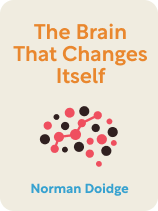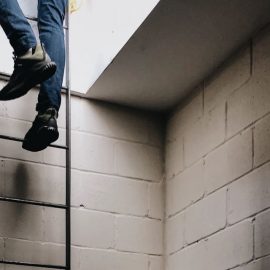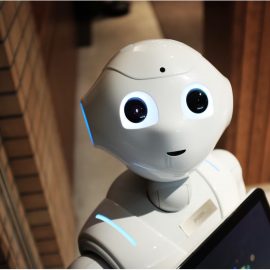

This article is an excerpt from the Shortform book guide to "The Brain That Changes Itself" by Norman Doidge. Shortform has the world's best summaries and analyses of books you should be reading.
Like this article? Sign up for a free trial here.
What is Norman Doidge’s The Brain That Changes Itself about? What is the key message to take away from the book?
In The Brain That Changes Itself, Norman Doidge explains that the brain is plastic, meaning it can change its own structure and connections in response to stimuli. This contrasts with the long-held belief that the brain is hardwired from an early age.
Below is a brief overview of Norman Doidge’s The Brain That Changes Itself: Stories of Personal Triumph From the Frontiers of Brain Science.
The Brain That Changes Itself: Stories of Personal Triumph From the Frontiers of Brain Science
Norman Doidge is a psychiatrist and psychoanalyst and the best-selling author of The Brain’s Way of Healing Itself. In The Brain That Changes Itself, Norman Doidge explains how the brain’s plastic nature can be used to improve outcomes for people suffering from severe brain damage or congenital brain disorders by restoring cognitive, sensory, and motor functions that have been lost or impaired. His book conveys complex ideas in a way that a layperson can understand and illustrates them through stories of real people whose lives have improved thanks to the power of neuroplasticity.
What Is Neuroplasticity and How Does It Work?
Doidge defines neuroplasticity as the brain’s ability to grow and reorganize itself in response to stimuli. Your brain is your processing center, and your brain’s structure and processes can change based on external or internal triggers to improve your brain’s performance and efficiency.
How do these changes in your brain happen? Doidge explains that the brain is made up of neurons, or nerve cells, which send signals to each other to produce every one of the brain’s functions. Neurons are separated by tiny spaces called synapses. When one neuron sends a signal to another neuron, it releases a chemical called a neurotransmitter into the synapse. The neurotransmitter then travels to the next neuron and delivers it a message.
Neurons can send and receive two types of messages: signals that cause other neurons to fire and signals that make other neurons less likely to fire. Neuroplastic change occurs when a specific type of signal is sent between neurons again and again, so that a pathway is formed between them, which makes them more likely to fire in that same way in the future.
According to Doidge, the more a pathway is used, the more efficient it becomes. This is why practicing something a lot—using the same neural pathway—makes it easier to do. This also means that pathways that are not used frequently are less efficient, which is why doing something new or that you’re not used to doing can be so difficult.
For example, if you’re right-handed, you’re more likely to use your right hand for most things you do because that neural pathway is well-established. However, if you want to increase your skill with your left hand, you can practice using it for those activities, and as the pathways controlling your left hand become stronger, you’ll become more skillful with that hand. This is what Doidge means by neuroplasticity: your brain’s ability to change your thoughts, abilities, and behaviors by forging new neural paths.
How Did the Concept of Neuroplasticity Develop?
Neuroplasticity wasn’t always considered valid in the field of neuroscience or related fields like psychology and biology. According to Doidge, the concept of the brain as plastic wasn’t taken seriously in the scientific community until around the 1960s. Instead, the brain was thought of as a machine with distinct parts designated for different functions. This was called localizationism and suggested the brain wasn’t capable of significant structural changes.
Neuroplasticity only became an accepted concept after many years of research provided the foundation for how the brain can change. In this section, we’ll examine localizationism and explore the evolution of our understanding of the brain, from mapping the areas of the brain with the functions they perform, to the critical period of neuroplasticity in infants, to the natural ways our brains change, and finally to how this information can be applied to modern treatments.
Early Beliefs: Localizationism, or the Machine-Like Brain
According to Doidge, localizationism was first proposed in 1861 by Paul Broca after he observed a patient who had a stroke and afterwards was unable to say anything except one word. Broca dissected the patient’s brain after death and found that the patient’s left frontal lobe was damaged. When dissections of other patients who had suffered speech loss also showed damage to that same area of the brain, it provided evidence for the idea that speech was controlled by the left frontal lobe specifically.
These observations were generalized, leading to a belief that, because certain areas seemed to control certain functions, those areas were the only ones that could ever control those functions, and that severe damage to one location meant those functions were lost forever.
This belief in the machine-like brain is part of why neuroplasticity wasn’t studied deeply until the second half of the 20th century. Another reason is that scientists didn’t have the technology to study the living brain at a microscopic level. They could dissect the brain during an autopsy, but they couldn’t examine the brain’s functions in real time until the development of electrode technology.
Doidge says a final reason neuroplasticity wasn’t seen as a valid theory was that people with severe brain damage almost never fully recovered, while damage in other parts of the body could be fully healed. Since the body could completely recover from a cut on the hand, the body was viewed as plastic, but the brain was viewed as unchangeable.
Developing a Map of the Brain
According to Doidge, scientists developed a “map” of the brain that showed which areas seemed to control which functions. If every function had a specific location in the brain, then scientists should be able to pinpoint those locations and their related functions—and they did. By using electrodes attached to living patients’ brains, experimenters were able to detect the location of electrical activity from certain stimuli. Though these brain maps were developed based on localizationism, they became very useful in the study of brain plasticity, as we’ll see later.
Wilder Penfield created the first full brain map by using an electric probe to manually activate certain areas of the brain and asking the patient what sensations they felt in response. For example, if he activated a place in the brain, and in response the patient said they felt pressure in their right foot, he would note that area as being associated with the right foot. Over the course of these procedures, he formed a map of the entire brain. Because the brain has no pain receptors, patients were able to stay awake during these types of brain surgeries so they could respond to Penfield’s questions.
Initially, Doidge says, electrodes could only measure brain activity on a large scale, detecting activity in thousands of neurons at once. Later, scientists developed microelectrodes that allowed them to view electrical activity at a microscopic level. Microelectrodes were so small they could be placed beside a neuron and monitor the activity there in response to stimuli like being touched.
Scientists could see that neurons that were physically near each other corresponded to body parts that were also physically near each other—for example, neurons controlling movement of the index finger were near neurons controlling the middle finger. The maps created in this way are even more detailed than modern brain scanning technology, but because the process is so tedious and time-consuming, it’s rarely used.
Discovery of the Critical Period: Plasticity in Infants
The research into brain mapping led to the discovery of the critical period in a person’s or animal’s early development. According to Doidge, the critical period is a span of time in infancy when our brains are absorbing immense amounts of information and developing connections at an extremely high rate. This is the period when our brain maps are first being built.
Continued research showed that during the critical period, unused parts of the brain can change themselves to perform functions different from their original functions. However, the belief was that once this critical period was over, the brain was set in stone for the rest of our lives.
Scientists David Hubel and Torsten Wiesel discovered the critical period by using electrodes to study the development of the visual cortex in kittens. When they sewed one eyelid shut during the kitten’s critical period (three to eight weeks), then later unsewed it, they found that the brain map for vision in that eye never developed—the cat remained blind in that eye for the rest of its life. However, they also found that the part of the cortex that would have processed input from the shut eye rewired itself to process input from the eye that was left open. This showed that the brain was capable of structural change, or plasticity, but Hubel and Wiesel believed that this plasticity ended once the critical period was over, and that the brain maps were then hardwired for the rest of the creature’s life.
Learning How Maps Change: The Competition for Brain Space
It was clear now that, at least in infancy, the brain was capable of restructuring itself in response to something like the loss of a sense. According to Doidge, further studies involving brain mapping showed that brain maps constantly change, even without interventions like removing input from a sense or part of the body. Mapping an animal once and then doing so again months later showed changes in the maps every time, indicating that our brains change in the normal course of our lives.
One experiment using monkeys showed that the brain wasn’t “hard-wired” to have a specific structure, indicating that the brain must be plastic. In the experiment, scientists disconnected the monkey’s nerves that control their thumb and forefinger, then reversed them. But the nerves reorganized themselves so that the monkey could still control its thumb and forefinger just as well as before.
Additional research led to the discovery of competitive neuroplasticity. According to Doidge, this means if a nerve stops working (is cut), the area of the brain that is connected to that nerve doesn’t just waste away. Instead, since the brain only has so much mass to perform all its different functions, the nerves that still work will use that leftover brain space, showing that there’s competition for limited resources within the brain. If you don’t use an area of the brain for its original purpose, it may be taken over by other functions you do still use.
To discover this, researchers again used monkeys as test subjects: They disconnected the nerve that controls the middle of the hand, or the median nerve, so that it wouldn’t receive any input from the middle of the hand. As expected, when the middle of the monkey’s hand was touched, the brain area connected to the median nerve no longer lit up. However, touching other areas of the monkey’s hand that were controlled by different nerves did cause that brain area to light up, meaning that brain area was now being used to detect input from those other nerves.
Training the Brain: Applications for Restoring Function
As we’ve seen, research showed that the neural connections in the brain were changing constantly and that they could even move around in the brain or disappear entirely depending on the functions demanded of the brain. According to Doidge, this meant that new connections must be forming between neurons that weren’t previously connected. Scientists realized that the brain’s ability to form new connections meant they might be able to treat or even cure things like learning disabilities and severe brain damage by training the neurons to fire in a more desirable way.
According to Doidge, a series of experiments by Edward Taub proved that we can train neurons to control a body part that doesn’t have sensory input. The experiments involved deafferenting the arms of monkeys: cutting sensory nerves so that the brain didn’t receive any sensation from the arms. Previous experiments with deafferenting monkeys showed that if one arm was deafferented, the monkey would only use the healthy arm, leading scientists to believe that motor control was dependent on sensation—once the neural connections for sensation were disconnected, the neural connections for movement became unusable.
Doidge says that Taub discovered the reason a monkey with one deafferented arm would begin using the healthy arm exclusively was because of learned nonuse. After surgery on the spinal cord, the neurons have trouble firing correctly—a condition called spinal shock, which results from damage to the spinal cord and usually lasts two to six months. An animal in spinal shock will try to use its deafferented arm, but because the neurons aren’t firing well, it will frequently fail to get the response it wants and eventually give up trying. It will learn to not use its deafferented arm and to use only the healthy one instead, thereby reinforcing only those neural pathways to the healthy arm while the pathways to the deafferented arm fall into disuse.
However, further experiments showed that learned nonuse could be prevented by restraining the deafferented limb until spinal shock wore off, because while the arm was restrained the monkey wouldn’t try—and fail—to use it, so once the restraint was taken off, it soon used its arm just like it had before surgery.
Taub also found that learned nonuse could be corrected if he forced a monkey to use its deafferented arm by restraining the healthy arm, and that it could even be corrected years after the deafferentation was performed. This had major implications for stroke victims who had lost movement in certain body parts, as we’ll see in the next section.
How Can Neuroplasticity Improve Our Lives?
Doidge says that neuroplasticity means we can change our brains to suit our needs. This has resulted in huge developments in neuroscience that have helped many people recover motor, sensory, and cognitive functions they had lost. Let’s look at some instances of such recovery.
Help for Stroke Patients
According to Doidge, Edward Taub used his research with monkeys to develop a treatment for regaining motor control called constraint-induced movement therapy, or CI therapy. If a patient loses the ability to use one of their arms—a common result of strokes—this therapy re-teaches them to use it by constraining their good hand. Being forced to use their affected hand in everyday activities causes the brain to rewire itself to make those movements possible and then easier.
Taub’s therapy regimens are founded on three principles: training with activities we do in everyday life is more effective; training should be incremental; and training is most effective in massed practice. This means the training should be done in short, concentrated periods, which is more effective than training over a long period of time with less frequency.
Help for Patients With Balance Loss
Because plasticity can allow the brain to substitute one sense for another, it can also help someone to regain a lost sense such as balance. Balance, or the vestibular sense, tends to weaken as we age, leading to more frequent falls. Balance issues can also occur from brain damage.
In order to restore a patient’s sense of balance, neuroscientists use a device called an accelerometer to stimulate the patient’s tongue according to the movement of their head, letting them sense a change in their balance through the sensations on their tongues.
When patients use this device, new connections form between their balance system and their tongue. This provides a residual effect, so even when they take off the device, their new balance system keeps going for a while. The more and longer the device is used, the longer the residual effect, and it can eventually become permanent, fixing the patient’s balance issues entirely.
Help for Patients With Phantom Limbs
Doidge says people with phantom limbs can also benefit from neuroplastic intervention. The term phantom limb refers to a sense of still having a limb that has been lost. So, for example, if you’ve had a leg amputated, you may develop a phantom leg that you can still feel as if the real leg were there. You may feel pain, pressure, or other sensations like itching, and you may also feel the physical sensation of moving that leg even though it’s not there anymore.
Some amputated limbs feel like a dead weight—like the limb is still there but is paralyzed or frozen. This happens because a limb is often immobilized with a cast or sling for a long time before the amputation. Scientists believe that the brain continues to send motor commands to it, only to receive no response to show that the limb is moving. Then, once the limb is amputated, the brain map that developed while it was immobilized—where the brain sends signals and the limb doesn’t respond—becomes fixed, and the brain continues to feel like the limb is there but is frozen or paralyzed.
Phantom pain works similarly. The brain continues to send commands to the amputated limb but receives no response, so the commands increase. The brain tries so hard to move the amputated limb that it causes the pain that your brain associates with trying too hard to move it (like how your hand hurts if you clench it too hard). According to Doidge, 95% of people who have a limb amputated suffer from long-term phantom pain.
To eradicate phantom pain, a device called a mirror box, developed by Vilayanur Subramanian Ramachandran, allows a patient who’s lost an arm to “see” their phantom arm by mirroring their good one. The box has two sections divided by a mirror. The patient places their existing arm into one section of the box and is then told to imagine putting their phantom arm into the other section. They then watch the reflection of their good hand and arm moving, which makes it look like their other arm is moving as well, and soon this causes them to feel like their phantom arm is moving along with the reflection. This ability to “move” their phantom arm helps relieve the pain they’re feeling, and over time, use of the mirror box can make the feeling of the phantom limb go away entirely.
Help for Patients With Learning Disorders
Neuroplastic research may even allow us to “cure” learning disabilities, asserts Doidge. By studying what areas of the brain are affected by a disability, we can create specific types of mental exercises to strengthen those areas and treat the disability. People who struggle with speaking, reading, and writing often have issues in their premotor cortex, for example, and can benefit from exercises that strengthen that part of the brain. These might include tracing exercises, which involve tracing complex characters or lines to stimulate the neurons in the premotor cortex. People who have issues with auditory processing—understanding and remembering spoken information—may benefit from memorizing poems and stories.
A regimen like this is highly individualized. Doidge suggests that providing all children, regardless of disability, with an individualized plan that targets their weak areas could vastly improve their education and abilities later in life.
He also suggests that implementing these plans early can make a big difference, because otherwise the child will often attribute their weaknesses to “stupidity,” start to dislike learning, and avoid the activity they struggle with, which prevents them from getting stronger in that area.
Drawbacks of Neuroplasticity
Unfortunately, brain plasticity may have downsides, says Doidge. Because, as we’ve discussed, plasticity is competitive, when one area of the brain becomes unused, it’s likely to be taken over by other functions that are used regularly. This can make it difficult to break bad habits because using the pathways involved with those habits not only strengthens them, but also weakens the pathways that are not used by the bad habit.
This also applies to learning a second language: The reason adults have more trouble learning a second language than children do is that the areas of their brain that process language are already being used to process their first language. It therefore takes more practice for an adult than for a child to create new pathways in that area to correspond to a second language. It’s easier to learn a second language while you’re acquiring your first language because the map of neural pathways for language widens to include both languages as they develop at the same time. However, when you’re learning a second language as an adult, that new language has to develop a brand new neural map rather than incorporating it into the first language’s map.
Doidge also suggests that neuroplasticity could be responsible for excessive worry and disorders like obsessive compulsive disorder. As your brain continually plays through anxiety-inducing scenarios, those pathways become stronger, which means you worry about them even more. Though it may be the cause, Doidge also says that neuroplasticity could be the cure for excessive worry and obsessive compulsive disorder. Therapy that involves reframing the worrisome thoughts into something positive, or distracting yourself with something positive, can help weaken the worry pathways that have become so strong.

———End of Preview———
Like what you just read? Read the rest of the world's best book summary and analysis of Norman Doidge's "The Brain That Changes Itself" at Shortform.
Here's what you'll find in our full The Brain That Changes Itself summary:
- How brain plasticity can help those with brain damage or congenital brain disorders
- Stories of real people whose lives have improved thanks to neuroplasticity
- A look at some of the negative effects neuroplasticity can have






